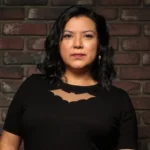Eufrosina Cruz Mendoza is a woman full of conviction. She is an activist for gender equality and the rights of indigenous women and communities. In 2007, Eufrosina Mendoza was elected president of Oaxaca’s municipal council, but was denied the position because she was an indigenous woman. This did not hinder her choice to continue into local politics. But as we see through the film, politics are not always the easiest way to create change and improve the lives of people. In the film, Eufrosina’s Revolution (La Revolución de los Alcatraces) we get to know the woman, her family, her community, her political career, and her hopes for improving the lives of all in the community.
Director Luciana Kaplan was in town for Hot Docs, and I was able to talk to her about Eufrosina, making the film, and her own opinions about her subject and the story.
Kaplan first met Eufrosina through a journalist friend of hers in 2010; at that point she was already known through Mexico and outside because of the media attention she’d been receiving. [Eufrosina’s] enery, sense of humour, charisma, and her welcoming attitude made it easier for Kaplan’s decision to visit her town of Santa María Quiegolani, Oaxaca. Two week after their initial meeting, Kaplan and her husband went to Santa María Quiegolani to visit Eufrosina and get to know her further. Once there, they realised there was an interesting story to tell. That Eufrosina is an interesting person, as is the context in which her story developed. With funding and the assistance of the Centro de Capacitación Cinematográfica, they ended up filming for two years.
Given that Eufrosina is a controversial figure, I was curious about how the locals responded to Kaplan and her team filming in Santa María Quiegolani. At first, the community just thought it was another member of the media doing a story on Eufrosina. But soon enough, Kaplan also received threats. Some people believed Kaplan and her team were siding with Eufrosina and her politics. There were some difficult moments but not from everyone. For the most part, people were quite nice with the team as a whole.
 |
| Eufrosina (right) with elder woman |
Because they were filming and following Eufrosina for two years, it is evident the community members did have a level of trust with Kaplan and the rest of the team. Kaplan describes it as having a certain ‘family-like’ relationship with Eufrosina, her family, and others in the town.
In terms of post-production, the film took one year for editing. As Kaplan described, “the hardest part was deciding what the story was about. Was it about politics, about success? Does Eufrosina tell her own story? The story did change through the course of time. Eufrosina’s politics also changed. That’s where I had to figure out how to thread the story together… what was the point, its structure.” At the end, the story is not really a story of Eufrosina’s success. She realises that being in politics does not allow her to make the improvements in her community, as she had hoped. Eufrosina herself says in the film that she was not aware what she was getting into. For social activists in Mexico is not an easy choice, “they either give in to power or are eaten by circumstances” said Kaplan.
I like this film not only because it shares the story of an indigenous Mexican woman but also because it allows Eufrosina to tell her story in her own words. And it takes us to a remote area in Oaxaca that is so full of culture and traditon, which sometimes makes adjusting to changes more difficult than expected.



